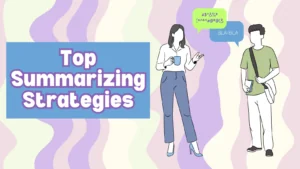Summarizing a book is an necessary skill for any student who ever came across literature class. It involves understanding the core ideas, themes, and plot, and then expressing them in a short and clear manner. Effective summarization helps students understand the core aspects of a book, making it easier to remember information and parttake in discussions. In this guide, we’ll explore the steps and techniques to summarize a book effectively. Don’t be scared of book summaries; they are more scared of you!

✅ AI Essay Writer ✅ AI Detector ✅ Plagchecker ✅ Paraphraser
✅ Summarizer ✅ Citation Generator

Understanding the Book
Hate to break it to you, but before summarizing a book you have to…read it. Yes, this step is absolutely necessary, if you want to great a high-quality summary. This involves more than just skimming through the pages; it requires active engagement with the material.
Active reading involves being fully present. As you read, highlight important passages, make annotations in the margins, and jot down your thoughts or questions. Note-taking is also a game-changer. Create a system that works for you, whether it’s bullet points, summaries of each chapter, or a mind map of the book’s concepts.
Examples of Identifying Key Themes, Characters, and Plot Points:
- In “To Kill a Mockingbird” by Harper Lee, key themes include racial injustice and moral growth, with characters like Atticus Finch and Scout playing crucial roles in a plot centered around a controversial trial in the racially segregated American South.
- In George Orwell’s “1984,” themes of totalitarianism and surveillance are explored, with characters like Winston Smith and Big Brother driving a plot that delves into the oppressive regime of Oceania.
By focusing on these elements, you’ll be able to grasp the essence of the book, setting a solid foundation for your summary. Here’s a more detailed mindmap of the famous “Great Gatsby”:

Creating an Outline
An outline is a roadmap for your summary that helps you organize your thoughts and present the information coherently.
Structuring your summary:
- Introduction: Start with a brief overview of the book, including the title, author, and a general idea of the plot and themes. This sets the stage for your summary.
- Body: This is where you dive into the details. Break down the plot into its main events, and discuss the key themes and characters. For each point, provide supporting details from the book to illustrate your points. It’s important to keep this section concise and focused on the most significant aspects of the story.
- Conclusion: Wrap up your summary by revisiting the main ideas and themes. You can also reflect on the overall impact of the book and its relevance.
Identify the central points in each section of the book and note down important quotes or events that illustrate these ideas, because by mentioning them your summary will look more credible to say the least.
Writing the Summary
Once you have your outline, it’s time to start writing the summary. Avoid complex words or phrases that might confuse the reader, because a summary is supposed to be easy to digest. Stick to straightforward language that projects the author’s ideas clearly. Choose words that accurately reflect the author’s intent without adding unnecessary detail. This helps to find a balance between the original meaning and the brevity of your text.
Focus on summarizing the content rather than interpreting it. Leave out your personal opinions or analysis to keep the summary objective. Remember, summaries and reviews are different!
Make sure that your summary accurately represents the main ideas and themes of the book, not just your subjective thoughts on it. It should reflect the author’s intent and convey the same message as the original text. While it’s important to use the author’s own words occasionally, we advise to rely mainly on paraphrasing to keep the summary short and sweet.
What about key events? Concentrate on the moments in the plot that drive the story forward. Avoid getting bogged down in minor details, because not every event or character needs to be included in the summary, even if you love them dearly. Choose those that are essential to understanding the overall story.
There is always another option available. You can explore our new tool to summarize online and better understand the concept of writing a solid summary.
Fine-Tuning Your Summary
After writing your summary, it’s important to review and revise it, like any other text. This process is crucial for refining your work and making sure it effectively communicates the key points of the book.
How to make this process less boring and more productive? Here, we got you:
- Sometimes, reading your summary out loud can help you identify awkward phrasing or unclear sentences.
- Make sure that your summary transitions smoothly between ideas and that each paragraph is logically(!) connected to the next and doesn’t just talk about random scenes from the book.
- Remove any repetitive information or unnecessary details that don’t contribute to the overall understanding of the book.
| Tip | Explanation |
|---|---|
| 📖 Stick to the Main Plot | Focus on the central storyline and avoid side plots that don’t significantly impact the main narrative. |
| 📍 Highlight Key Themes | Make sure to include the main themes and messages conveyed by the author. |
| 🖇 Include Important Characters | Mention the main characters and their roles in the story, but avoid detailing every character. |
| 📝 Maintain the Author’s Tone | Try to reflect the author’s style and tone in your summary to preserve the original feel of the book. |
After following these tips and carefully reviewing your summary, you can rest assured that it accurately tells the main story and provides readers with a good understanding of the book. Summarizing a book is a skill that requires active reading, critical thinking, and concise writing. Remember, practice is key to perfection. The more you summarize, the better you’ll become at breaking down complex information into digestible, clear summaries. Good luck!
FAQ
Follow us on Reddit for more insights and updates.





Comments (0)
Welcome to A*Help comments!
We’re all about debate and discussion at A*Help.
We value the diverse opinions of users, so you may find points of view that you don’t agree with. And that’s cool. However, there are certain things we’re not OK with: attempts to manipulate our data in any way, for example, or the posting of discriminative, offensive, hateful, or disparaging material.